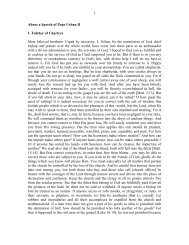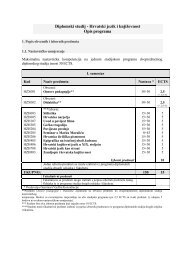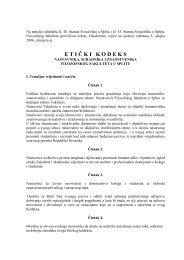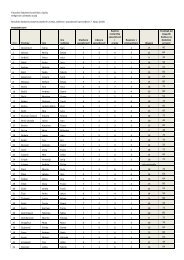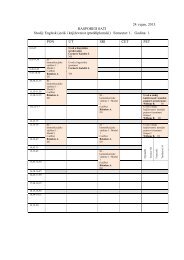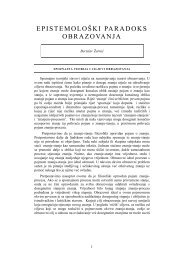Understanding Human Communication
Understanding Human Communication
Understanding Human Communication
You also want an ePaper? Increase the reach of your titles
YUMPU automatically turns print PDFs into web optimized ePapers that Google loves.
leader’s concern for production.This involves a focus on accomplishing the organizational<br />
task, with efficiency being the main concern.The vertical axis<br />
measures the leader’s concern for people’s feelings and ideas. Blake and Mouton<br />
suggest that the most effective leader is the one who adopts a 9,9 style—showing<br />
high concern for both task and relationships.<br />
SITUATIONAL APPROACHES Most contemporary<br />
scholars are convinced that the best<br />
style of leadership varies from one set of circumstances<br />
to another. 35 In an effort to pin<br />
down which approach works best in a<br />
given type of situation, psychologist Fred<br />
Fiedler attempted to find out when a taskoriented<br />
approach was most effective and<br />
when a more relationship-oriented approach<br />
was most effective. 36 From his research,<br />
Fiedler developed a situational theory of leadership.<br />
Although the complete theory is too<br />
complex to describe here, the general conclusion<br />
of situational leadership is that a<br />
leader’s style should change with the circumstances.<br />
A task-oriented approach works<br />
best when conditions are either highly favorable<br />
(good leader-member relations,<br />
strong leader power,and clear task structure)<br />
or highly unfavorable (poor leader-member<br />
relations, weak leader power, and an ambiguous<br />
task), whereas a more relationshiporiented<br />
approach is appropriate in moderately<br />
favorable or moderately unfavorable<br />
conditions.<br />
More recently, Paul Hersey and Kenneth<br />
Blanchard have suggested that a leader’s focus<br />
on task or relational issues should vary<br />
according to the readiness of the group being<br />
led (see Figure 9–3). 37 Readiness involves the<br />
members’ level of motivation, willingness to<br />
take responsibility,and the amount of knowledge<br />
and experience they have in a given<br />
situation. For example, a new, inexperienced<br />
group would need more task-related direction,<br />
whereas a more experienced group<br />
might require more social support and less<br />
instruction about how to do the job. A wellseasoned<br />
group could probably handle the<br />
job well without much supervision at all.<br />
Because an employee’s readiness changes<br />
from one job to another, Hersey and Blanchard<br />
suggest that the best way to lead<br />
should vary as well.<br />
HIGH<br />
(Supportive Behavior)<br />
RELATIONSHIP BEHAVIOR<br />
LOW<br />
CHAPTER 9 SOLVING PROBLEMS IN GROUPS 315<br />
CULTURAL IDIOM<br />
to pin down: to identify<br />
specifically<br />
SITUATIONAL LEADERSHIP ®<br />
LEADER BEHAVIOR<br />
S3 S2<br />
Share ideas<br />
and facilitate<br />
in decision<br />
making<br />
Lo. Rel.<br />
Lo. Task<br />
S4<br />
DELEGATING PARTICIPATING<br />
Hi. Rel.<br />
Lo. Task<br />
Turn over<br />
responsibility<br />
for decisions<br />
and<br />
implementation<br />
SELLING<br />
Hi. Task<br />
Hi. Rel.<br />
S1<br />
Provide<br />
specific<br />
instructions<br />
and closely<br />
supervise<br />
performance<br />
TASK BEHAVIOR<br />
GUIDANCE<br />
FOLLOWER READINESS<br />
TELLING<br />
Explain<br />
decisions<br />
and<br />
provide<br />
opportunity<br />
for<br />
clarification<br />
Hi. Task<br />
Lo. Rel.<br />
HIGH MODERATE<br />
LOW<br />
R4 R3 R2 R1<br />
Able and<br />
willing<br />
or confident<br />
FOLLOWER<br />
DIRECTED<br />
Able but<br />
unwilling<br />
or insecure<br />
Unable but<br />
willing<br />
or confident<br />
LEADER<br />
DIRECTED<br />
HIGH<br />
Unable and<br />
unwilling<br />
or insecure<br />
Figure 9-3 Hersey and Blanchard’s Leadership Model Source: “Situational<br />
Leadership Behavior.” From Management of Organizational Behavior,<br />
8th edition, © 2001. Adapted/reprinted with permission of Center for Leadership<br />
Studies, Escondido, CA 92025. All Rights Reserved.



